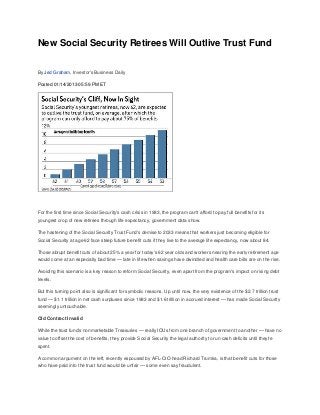New social security retirees will outlive trust fund
•Download as DOCX, PDF•
0 likes•183 views
New Social Security
Report
Share
Report
Share

Recommended
Recommended
More Related Content
Featured
Featured (20)
Product Design Trends in 2024 | Teenage Engineerings

Product Design Trends in 2024 | Teenage Engineerings
How Race, Age and Gender Shape Attitudes Towards Mental Health

How Race, Age and Gender Shape Attitudes Towards Mental Health
AI Trends in Creative Operations 2024 by Artwork Flow.pdf

AI Trends in Creative Operations 2024 by Artwork Flow.pdf
Content Methodology: A Best Practices Report (Webinar)

Content Methodology: A Best Practices Report (Webinar)
How to Prepare For a Successful Job Search for 2024

How to Prepare For a Successful Job Search for 2024
Social Media Marketing Trends 2024 // The Global Indie Insights

Social Media Marketing Trends 2024 // The Global Indie Insights
Trends In Paid Search: Navigating The Digital Landscape In 2024

Trends In Paid Search: Navigating The Digital Landscape In 2024
5 Public speaking tips from TED - Visualized summary

5 Public speaking tips from TED - Visualized summary
Google's Just Not That Into You: Understanding Core Updates & Search Intent

Google's Just Not That Into You: Understanding Core Updates & Search Intent
The six step guide to practical project management

The six step guide to practical project management
Beginners Guide to TikTok for Search - Rachel Pearson - We are Tilt __ Bright...

Beginners Guide to TikTok for Search - Rachel Pearson - We are Tilt __ Bright...
New social security retirees will outlive trust fund
- 1. New Social Security Retirees Will Outlive Trust Fund By Jed Graham, Investor's Business Daily Posted 01/14/2013 05:59 PM ET For the first time since Social Security's cash crisis in 1983, the program can't afford to pay full benefits for its youngest crop of new retirees through life expectancy, government data show. The hastening of the Social Security Trust Fund's demise to 2033 means that workers just becoming eligible for Social Security at age 62 face steep future benefit cuts if they live to the average life expectancy, now about 84. Those abrupt benefit cuts of about 25% a year for today's 62 year olds and workers nearing the early retirement age would come at an especially bad time — late in life when savings have dwindled and health care bills are on the rise. Avoiding this scenario is a key reason to reform Social Security, even apart from the program's impact on rising debt levels. But this turning point also is significant for symbolic reasons. Up until now, the very existence of the $2.7 trillion trust fund — $1.1 trillion in net cash surpluses since 1983 and $1.6 trillion in accrued interest — has made Social Security seemingly untouchable. Old Contract Invalid While the trust fund's nonmarketable Treasuries — really IOUs from one branch of government to another — have no value to offset the cost of benefits, they provide Social Security the legal authority to run cash deficits until they're spent. A common argument on the left, recently espoused by AFL-CIO head Richard Trumka, is that benefit cuts for those who have paid into the trust fund would be unfair — some even say fraudulent.
- 2. "There is no justice at all in considering cuts to prepaid, earned-benefit programs like Social Security," Trumka wrote in a recent op-ed. Yet the argument that benefit cuts would break a near-sacred contract is no longer valid now that full benefits are no longer prepaid. Benefit cuts are built into current law and, in effect, written into the contract with workers. Under current law, a worker who just turned 62 would face a 25% benefit cut once the trust is spent in early 2033. If that worker claims benefits at 62 and lives to the average expectancy of 84, she would face the equivalent of a 1% cut in lifetime retirement benefits. Workers now 61 would, on average, lose the equivalent of a half year in benefits and face a 2% cut in lifetime benefits. Workers now 55 would, on average, lose two full years' worth of benefits, the equivalent of a 9.2% cut in lifetime benefits.